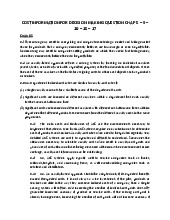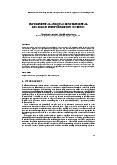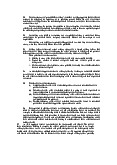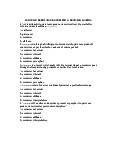



















Preview text:
CHAPTER 2
AN INTRODUCTION TO COST TERMS AND PURPOSES 2-1
A cost object is anything for which a separate measurement of costs is desired. Examples
include a product, a service, a project, a customer, a brand category, an activity, and a department. 2-2
Direct costs of a cost object are related to the particular cost object and can be traced to
that cost object in an economically feasible (cost-effective) way.
Indirect costs of a cost object are related to the particular cost object but cannot be traced
to that cost object in an economically feasible (cost-effective) way.
Cost assignment is a general term that encompasses the assignment of both direct costs
and indirect costs to a cost object. Direct costs are
traced to a cost object while indirect costs are
allocated to a cost object. 2-3
Managers believe that direct costs that are traced to a particular cost object are more
accurately assigned to that cost object than are indirect allocated costs. When costs are allocated,
managers are less certain whether the cost allocation base accurately measures the resources
demanded by a cost object. Managers prefer to use more accurate costs in their decisions. 2.4
Factors affecting the classification of a cost as direct or indirect include
the materiality of the cost in question,
available information-gathering technology, design of operations 2.5
A variable cost changes in total in proportion to changes in the related level of total
activity or volume. An example is a sales commission that is a percentage of each sales revenue dollar.
A fixed cost remains unchanged in total for a given time period, despite wide changes in
the related level of total activity or volume. An example is the leasing cost of a machine that is
unchanged for a given time period (such as a year) regardless of the number of units of product produced on the machine. 2-6
A cost driver is a variable, such as the level of activity or volume, that causally affects
total costs over a given time span. A change in the cost driver results in a change in the level of
total costs. For example, the number of vehicles assembled is a driver of the costs of steering
wheels on a motor-vehicle assembly line. 2-7
The relevant range is the band of normal activity level or volume in which there is a
specific relationship between the level of activity or volume and the cost in question. Costs are
described as variable or fixed with respect to a particular relevant range. 2-8
A unit cost is computed by dividing some amount of total costs (the numerator) by the
related number of units (the denominator). In many cases, the numerator will include a fixed cost
that will not change despite changes in the denominator. It is erroneous in those cases to multiply
the unit cost by activity or volume change to predict changes in total costs at different activity or volume levels. 2-9
Manufacturing-sector companies purchase materials and Ashtonnents and convert them
into various finished goods, for example automotive and textile companies. 2-1
Merchandising-sector companies purchase and then sell tangible products without
changing their basic form, for example retailing or distribution.
Service-sector companies provide services or intangible products to their customers, for
example, legal advice or audits. 2.10
Manufacturing companies have one or more of the following three types of inventory:
1. Direct materials inventory. Direct materials in stock and awaiting use in the manufacturing process.
2. Work-in-process inventory. Goods partially worked on but not yet completed. Also
called work in progress.
3. Finished goods inventory. Goods completed but not yet sold. 2.11
Inventoriable costs are all costs of a product that are considered as assets in the balance
sheet when they are incurred and that become cost of goods sold when the product is sold. These
costs are included in work-in-process and finished goods inventory (they are “inventoried”) to
accumulate the costs of creating these assets.
Period costs are all costs in the income statement other than cost of goods sold. These
costs are treated as expenses of the accounting period in which they are incurred because they are
expected not to benefit future periods (because there is not sufficient evidence to conclude that
such benefit exists). Expensing these costs immediately best matches expenses to revenues. 2-12
Direct material costs are the acquisition costs of all materials that eventually become part
of the cost object (work in process and then finished goods), and can be traced to the cost object
in an economically feasible way.
Direct manufacturing labor costs include the compensation of all manufacturing labor
that can be traced to the cost object (work in process and then finished goods) in an economically feasible way.
Manufacturing overhead costs are all manufacturing costs that are related to the cost
object (work in process and then finished goods), but cannot be traced to that cost object in an economically feasible way.
Prime costs are all direct manufacturing costs (direct material and direct manufacturing labor).
Conversion costs are all manufacturing costs other than direct material costs. 2-13
Overtime premium is the wage rate paid to workers (for both direct labor and indirect
labor) in excess of their straight-time wage rates.
Idle time is a subclassification of indirect labor that represents wages paid for
unproductive time caused by lack of orders, machine breakdowns, material shortages, poor scheduling, and the like. 2-14
A product cost is the sum of the costs assigned to a product for a specific purpose.
Purposes for computing a product cost include
pricing and product mix decisions,
contracting with government agencies, and
preparing financial statements for external reporting under generally accepted accounting principles. 2-15
Three common features of cost accounting and cost management are:
calculating the costs of products, services, and other cost objects 2-2
obtaining information for planning and control and performance evaluation
analyzing the relevant information for making decisions 2-16
(15 min.) Computing and interpreting manufacturing unit costs. 1. (in millions) Supreme Deluxe Regular Total Direct material cost $ 89.00 $ 57.00 $60.00 $206.00 Direct manuf. labor costs 16.00 26.00 8.00 50.00 Manufacturing overhead costs 48.00 78.00 24.00 150.00 Total manuf. costs 153.00 161.00 92.00 406.00
Fixed costs allocated at a rate of $15M $50M (direct mfg. labor) equal to $0.30 per dir. manuf. labor dollar (0.30 $16; 26; 8) 4.80 7.80 2.40 15.00 Variable costs $148.20 $153.20 $89.60 $391.00 Units produced (millions) 125 150 140 Cost per unit (Total manuf. costs ÷ units produced) $1.2240 $1.0733 $0.6571 Variable manuf. cost per unit (Variable manuf. costs Units produced) $1.1856 $1.0213 $0.6400 (in millions) Supreme Deluxe Regular Total 2. Based on total manuf. cost per unit ($1.2240 150;
$1.0733 190; $0.6571 220) $183.60 $203.93 $144.56 $532.09
Correct total manuf. costs based on variable manuf. costs plus fixed costs equal
Variable costs ($1.1856 150; $177.84 $194.05 $140.80 $512.69
$1.0213 190; $0.64 220) Fixed costs 15.00 Total costs $527.69
The total manufacturing cost per unit in requirement 1 includes $15 million of indirect
manufacturing costs that are fixed irrespective of changes in the volume of output per month,
while the remaining variable indirect manufacturing costs change with the production volume.
Given the unit volume changes for August 2011, the use of total manufacturing cost per unit
from the past month at a different unit volume level (both in aggregate and at the individual
product level) will overestimate total costs of $532.09 million in August 2011 relative to the
correct total manufacturing costs of $527.69 million calculated using variable manufacturing cost
per unit times units produced plus the fixed costs of $15 million.
2-17 (15 min.) Direct, indirect, fixed and variable costs. 1. Yeast – direct, variable Flour- direct, variable 2-3
Packaging materials –direct (or could be indirect if small and not traced to each unit), variable
Depreciation on ovens –indirect, fixed (unless “units of output” depreciation, which then would be variable)
Depreciation on mixing machines–indirect, fixed (unless “units of output” depreciation, which then would be variable)
Rent on factory building – indirect, fixed
Fire Insurance on factory building–indirect, fixed
Factory utilities – indirect, probably some variable and some fixed (e.g. electricity may be
variable but heating costs may be fixed)
Finishing department hourly laborers – direct, variable (or fixed if the laborers are under a union contract)
Mixing department manager – indirect, fixed
Materials handlers –depends on how they are paid. If paid hourly and not under union
contract, then indirect, variable. If salaried or under union contract then indirect, fixed
Custodian in factory –indirect, fixed
Night guard in factory –indirect, fixed
Machinist (running the mixing machine) –depends on how they are paid. If paid hourly and
not under union contract, then indirect, variable. If salaried or under union contract then indirect, fixed
Machine maintenance personnel – indirect, probably fixed, if salaried, but may be variable if
paid only for time worked and maintenance increases with increased production
Maintenance supplies – indirect, variable
Cleaning supplies – indirect, most likely fixed since the custodians probably do the same amount of cleaning every night
2. If the cost object is Mixing Department, then anything directly associated with the Mixing
Department will be a direct cost. This will include:
Depreciation on mixing machines Mixing Department manager
Materials handlers (of the Mixing Department)
Machinist (running the mixing machines)
Machine Maintenance personnel (of the Mixing Department)
Maintenance supplies (if separately identified for the Mixing Department)
Of course the yeast and flour will also be a direct cost of the Mixing Department, but it is already
a direct cost of each kind of bread produced. 2-4 2-18
(15–20 min.) Classification of costs, service sector.
Cost object: Each individual focus group
Cost variability: With respect to the number of focus groups
There may be some debate over classifications of individual items, especially with regard to cost variability. Cost Item D or I V or F A D V B I F C I Va D I F E D V F I F G D V H I Vb
aSome students will note that phone call costs are variable when each call has a separate charge. It may be a fixed
cost if Consumer Focus has a flat monthly charge for a line, irrespective of the amount of usage.
bGasoline costs are likely to vary with the number of focus groups. However, vehicles likely serve multiple
purposes, and detailed records may be required to examine how costs vary with changes in one of the many purposes served. 2-19
(15–20 min.) Classification of costs, merchandising sector.
Cost object: Videos sold in video section of store
Cost variability: With respect to changes in the number of videos sold
There may be some debate over classifications of individual items, especially with regard to cost variability. Cost Item D or I V or F A D F B I F C D V D D F E I F F I V G I F H D V 2-5 2-20
(15–20 min.) Classification of costs, manufacturing sector.
Cost object: Type of car assembled (Corolla or Geo Prism)
Cost variability: With respect to changes in the number of cars assembled
There may be some debate over classifications of individual items, especially with regard to cost variability. Cost Item D or I V or F A D V B I F C D F D D F E D V F I V G D V H I F 2-21 (20 min.)
Variable costs, fixed costs, total costs. 1. Minutes/month 0 50 100 150 200 240 300 327.5 350 400 450 510 540 600 650 Plan A ($/month) 0 5 10 15 20 24 30 32.75 35 40 45 51 54 60 65 Plan B ($/month) 15 15 15 15 15 15 19.80 22 23.80 27.80 31.80 36.60 39 43.80 47.80 Plan C ($/month) 22 22 22 22 22 22 22 22 22 22 22 22 23.50 26.50 29 2.
In each region, Ashton chooses the plan that has the lowest cost. From the graph (or from
calculations)*, we can see that if Ashton expects to use 0–150 minutes of long-distance each
month, she should buy Plan A; for 150–327.5 minutes, Plan B; and for over 327.5 minutes,
Plan C. If Ashton plans to make 100 minutes of long-distance calls each month, she should
choose Plan A; for 240 minutes, choose Plan B; for 540 minutes, choose Plan C.
*Let x be the number of minutes when Plan A and Plan B have equal cost $0.10x = $15
x = $15 ÷ $0.10 per minute = 150 minutes.
Let y be the number of minutes when Plan B and Plan C have equal cost
$15 + $0.08 (y – 240) = $22
$0.08 (y – 240) = $22 – $15 = $7 $7 87.5 y – 240 = $0.08
y = 87.5 + 240 = 327.5 minutes 2-6 2-22
(15–20 min.) Variable costs and fixed costs. 1.
Variable cost per ton of beach sand mined Subcontractor $ 80 per ton Government tax 50 per ton Total $130 per ton Fixed costs per month
0 to 100 tons of capacity per day = $150,000
101 to 200 tons of capacity per day = $300,000
201 to 300 tons of capacity per day = $450,000 2. $450,000 $975,0 00 sts sts o o C C $300,000 le $650,0 00 ed riab ix a F l $325,0 00 ta $150,000 otalV To T 2,5 00 5,000 7,500 100 200 300 Tons Min ed Tons o f Cap aci ty p er Day
The concept of relevant range is potentially relevant for both graphs. However, the question does
not place restrictions on the unit variable costs. The relevant range for the total fixed costs is
from 0 to 100 tons; 101 to 200 tons; 201 to 300 tons, and so on. Within these ranges, the total
fixed costs do not change in total. 3. Tons Mined Tons Mined Fixed Unit Variable Unit Total Unit per Day per Month Cost per Ton Cost per Ton Cost per Ton (1) (2) = (1) × 25 (3) = FC ÷ (2) (4) (5) = (3) + (4) (a) 180 4,500 $300,000 ÷ 4,500 = $66.67 $130 $196.67 (b) 220 5,500 $450,000 ÷ 5,500 = $81.82 $130 $211.82
The unit cost for 220 tons mined per day is $211.82, while for 180 tons it is only $196.67. This
difference is caused by the fixed cost increment from 101 to 200 tons being spread over an
increment of 80 tons, while the fixed cost increment from 201 to 300 tons is spread over an increment of only 20 tons. 2-7
2-23 (20 min.) Variable costs, fixed costs, relevant range. 1.
The production capacity is 4,100 jaw breakers per month. Therefore, the current annual
relevant range of output is 0 to 4,100 jaw breakers × 12 months = 0 to 49,200 jaw breakers. 2.
Current annual fixed manufacturing costs within the relevant range are $1,200 × 12 =
$14,400 for rent and other overhead costs, plus $9,000 ÷ 10 = $900 for depreciation, totaling $15,300.
The variable costs, the materials, are 30 cents per jaw breaker, or $13,680 ($0.30 per jaw
breaker × 3,800 jaw breakers per month × 12 months) for the year. 3.
If demand changes from 3,800 to 7,600 jaw breakers per month, or from 3,800 × 12 =
45,600 to 7,600 × 12 = 91,200 jaw breakers per year, Sweetum will need a second machine.
Assuming Sweetum buys a second machine identical to the first machine, it will increase
capacity from 4,100 jaw breakers per month to 8,200. The annual relevant range will be between
4,100 × 12 = 49,200 and 8,200 × 12 = 98,400 jaw breakers.
Assume the second machine costs $9,000 and is depreciated using straight-line
depreciation over 10 years and zero residual value, just like the first machine. This will add $900 of depreciation per year.
Fixed costs for next year will increase to $16,200 from $15,300 for the current year + $900
(because rent and other fixed overhead costs will remain the same at $14,400). That is, total
fixed costs for next year equal $900 (depreciation on first machine) + $900 (depreciation on
second machine) + $14,400 (rent and other fixed overhead costs).
The variable cost per jaw breaker next year will be 90% × $0.30 = $0.27. Total variable
costs equal $0.27 per jaw breaker × 91,200 jaw breakers = $24,624.
If Sweetum decides to not increase capacity and meet only that amount of demand for
which it has available capacity (4,100 jaw breakers per month or 4,100 × 12 = 49,200 jaw
breakers per year), the variable cost per unit will be the same at $0.30 per jaw breaker. Annual
total variable manufacturing costs will increase to $0.30 × 4,100 jaw breakers per month × 12
months = $14,760. Annual total fixed manufacturing costs will remain the same, $15,300. 2-8
2.24 (20 min.) Cost drivers and value chain.
1. Identify customer needs (what do smartphone users want?) — Design of products and processes
Perform market research on competing brands — Design of products and processes
Design a prototype of the HCP smartphone — Design of products and processes
Market the new design to cell phone companies — Marketing
Manufacture the HCP smartphone — Production
Process orders from cell phone companies — Distribution
Package the HCP smartphones — Production
Deliver the HCP smartphones to the cell phone companies — Distribution
Provide online assistance to cell phone users for use of the HCP smartphone — Customer Service
Make design changes to the HCP smartphone based on customer feedback — Design of products and processes 2. Value Chain Category Activity Cost driver Design of Identify customer needs
Number of surveys returned and processed products and
from competing smartphone users processes Perform market research on
Hours spent researching competing market competing brands brands
Number of surveys returned and processed
from competing smartphone users Design a prototype of the HCP
Engineering hours spent on initial product smartphone design Make design changes to the Number of design changes smartphone based on customer feedback Production Manufacture the HCP
Machine hours required to run the smartphones production equipment Package the HCP smartphones
Number of smartphones shipped by HCP Marketing Market the new design to cell
Number of cell phone companies purchasing phone companies the HCP smartphone Distribution
Process orders from cell phone
Number of smartphone orders processed companies
Number of deliveries made to cell phone companies Deliver the HCP smartphones
Number of deliveries made to cell phone to cell phone companies companies Customer Provide on-line assistance to
Number of smartphones shipped by HCP Service cell phone users for use of Customer Service hours the HCP smartphone 2-9 2-25
(10–15 min.) Cost drivers and functions. 1. Function
Representative Cost Driver 1. Accounting
Number of transactions processed 2. Human Resources Number of employees 3. Data processing
Hours of computer processing unit (CPU) 4. Research and development Number of research scientists 5. Purchasing Number of purchase orders 6. Distribution Number of deliveries made 7. Billing Number of invoices sent 2. Function
Representative Cost Driver 1. Accounting Number of journal entries made 2. Human Resources
Salaries and wages of employees 3. Data Processing
Number of computer transactions 4. Research and Development
Number of new products being developed 5. Purchasing
Number of different types of materials purchased 6. Distribution
Distance traveled to make deliveries 7. Billing
Number of credit sales transactions 2-10



